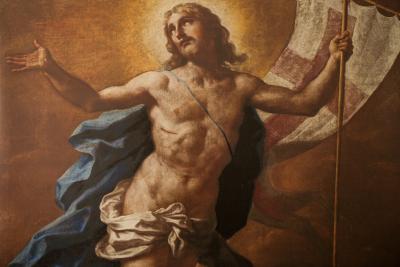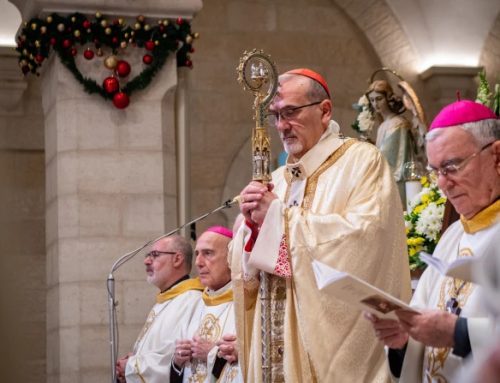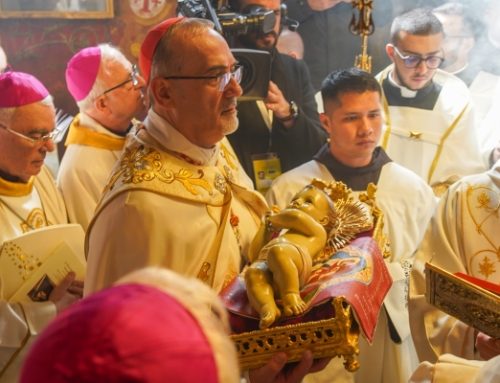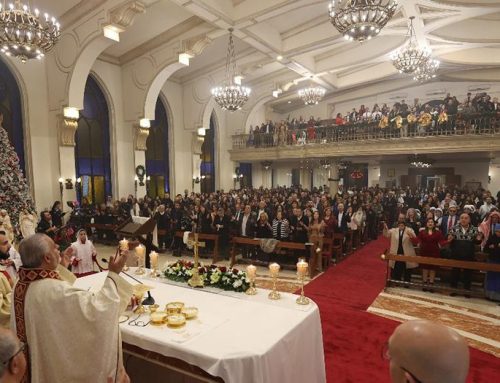Ten years ago, the restoration of the canvas
There is no pilgrim who has not lingered to gaze, at least in the last three centuries, at the painting which dominates the upper part of the Edicule of the Holy Sepulchre, above the low door which leads to the chapel of the Angel.
It is the Resurrection of Christ, oil on canvas, without any doubt the work of Paolo De Matteis, the painter born in Piano Vetrale di Orria, today in the province of Salerno (Italy), and dated to between the end of the 17th and the early 18th centuries.
The painting now almost forms a single entity with the Sepulchre: and the canvas can boast of something extraordinarily unique, because of all the representations of the resurrection, this one is placed exactly in the place where the event took place, showing the culminating moment of the Christian faith.
The last restoration of the canvas
“We discovered the signature of the artist only ten years ago,” said Fra Stéphane Milovitch, President of the Holy Sepulchre, “when it came to light after three months of restoration. The work on the canvas had become necessary due to the dust, but above all the black smoke from the candles beneath, all of which are factors that together with its location, did not allow correctly identifying the painter.”
“On the wishes of the French gallery-owner Maurizio Canesso and Professor Nicola Spinosa, Director of the Museum of Capodimonte (Naples),” Fra Stéphane continued, “the painting, after the exhibition at the Palace of Versailles on “The Treasure of the Holy Sepulchre”, was sent to be restored at the Atelier of Serge Tiers in Paris between the end of 2013 and the beginning of 2014.”
This restoration turned out to be particularly important because now the canvas is protected by a panel of special glass and, on the back, by a panel of alveolar polypropylene which lets the painting breathe without becoming dusty or turning black.
The Resurrection of the Holy Sepulchre
The victory over death is told through the figure of Christ glorious enveloped in a delicate and warm light. His body shows a plasticity which recalls the sculptures of Greek classicism, but this is not a heroic or grandiose Christ: rather he tends more towards ecstasy.
It is his eyes which catalyse attention, because in the soft incarnate of his serene face, his eyes look up to heaven, to which his body is ascending delicately and mysteriously.
The movement of Christ invites every faithful who halts in front of the Sepulchre to reflect on the last reality that will open up for each person at the end of their earthly life: the Kingdom of God, to which the intense lapis lazuli blue of the mantle, which envelops the hips, opening upwards as though in the wind, alludes.
The artist Paolo de Matteis
In certain aspects, the canvas of the Holy Sepulchre by Paolo de Matteis evokes the painting by Luca Giordano, one of the greatest representatives of baroque Neapolitan painting, but the elegance of this work and the more luminous and gentle painting of the features, are characteristics which already mark the passage from the Baroque to Rococo, which took place in Italy straddling the 17th century.
“The painting was already placed here from the end of the 17th century,” Fra Stéphane points out, “perhaps following the wishes of a Neapolitan benefactor, a religious of the Order of Friars Minor leaving for Jerusalem. Over time, the three communities to whom the tomb of Christ belongs – Catholic, Greek Orthodox and Armenian – have all been able to keep lamps, candelabra and paintings inside and outside the edicule. This painting, thanks to its particular location, is definitely one of the most seen and admired works of art on the Resurrection.”
By Silvia Giuliano | custodia






